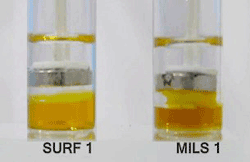Report: Researchers develop world’s first magnetic soap
Team at the University of Bristol successfully produce game-changing product
Scientists at the University of Bristol have made a breakthrough discovery by developing the world’s first magnetic soap.

Magnetic soap. (Via: phys.org)
What makes this discovery so exciting is that it could revolutionize industrial cleaning products and create a whole range of highly effective, remarkably efficient cleaning materials, covering everything from household needs to treating environmental disasters like oil spills.
How they did it
The Bristol team, led by Professor Julian Eastoe, created the magnetic soap by dissolving iron in a range of inert surfactants composed of chloride and bromide ions, materials similar to those found in everyday household products like mouthwash and fabric softener.
When they did this, they created soap particles with metallic centers. This gave the material the unique ability to overcome both gravity and surface tension between oil and water in order to rise up through the organic solvent and reach a magnet in a test tube (below).

Test tube on left contains unaltered surfactant and magnet; tube on the right contains modified surfactant being drawn to magnet. (Via: chm.bris.ac.uk)
It’s been suggested in the past that ionic liquid surfactants could be controlled by magnets, but it was always assumed that their metallic centers would be too isolated within the solution to be magnetically reactive. To overcome their doubts about the material they produced, Eastoe and his team subjected the material to a technique called small-angle neutron scattering (SANS), essentially a neutron microscope. Sure enough, there under the lens, the material showed that the dissolved iron had clumped together, thereby giving the soap its magnetic properties.
Benefits of magnetic soap
By making soap magnetic, manufacturers can alter the material’s properties, including its electrical conductivity and melting point, simply by turning a magnetic field on or off. Traditionally, these factors are controlled using electricity, or changing the pH or temperature of the system. These processes are expensive and once the changes have been made, they irreversibly alter the system’s composition.
How does this work with oil spills?

Using soap to clean up oil spills like this one in China can have a detrimental effect on the local ecosystem. (Via: earthmindshare.com)
One of the biggest problems with oil spill clean-ups is that in the process of removing oil, huge loads of soap are left behind. This can be just as harmful as oil in disrupting the local ecosystem.
With magnetic soap, it only works when needed. So workers can apply it to treat a spill site, and then just as easily remove it from the area by applying a magnetic field.
Professor Eastoe’s take
The star of the discovery, Professor Eastoe, elaborated on the finding: “As most magnets are metals, from a purely scientific point of view these ionic liquid surfactants are highly unusual, making them a particularly interesting discovery.”
He added: “From a commercial point of view, though these exact liquids aren’t yet ready to appear in any household product, by proving that magnetic soaps can be developed, future work can reproduce the same phenomenon in more commercially viable liquids for a range of applications from water treatment to industrial cleaning products.”
So, while we might not see “Magnetisoap” by Palmolive on the supermarket shelves any time soon, there’s a distinct possibility that magnetic soap could be available for industrial purposes at some point down the road. ■
Story via: bris.ac.uk/news/2012/8179.html
Abstract of published discovery in Angewandte Chemie: onlinelibrary.wiley.com/doi/10.1002/anie.201108010/abstract;jsessionid=FBC5B5E55CA6496B20221838BE732E5B.d03t04
Advertisement
Learn more about Electronic Products Magazine





